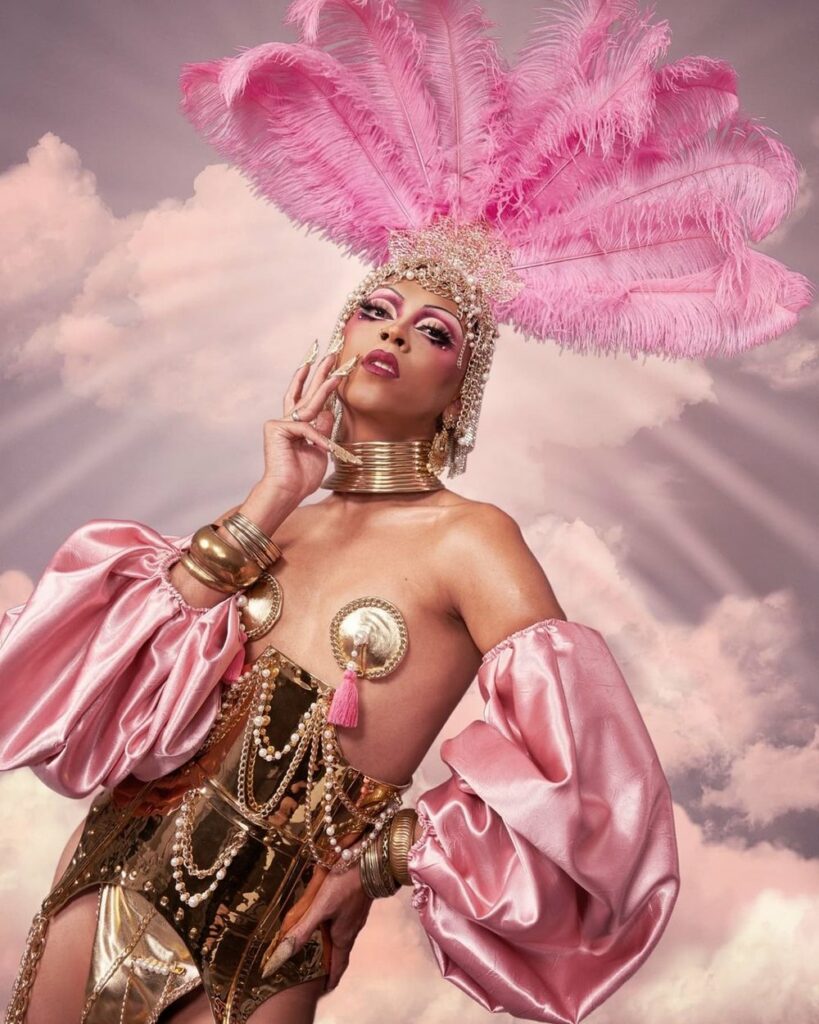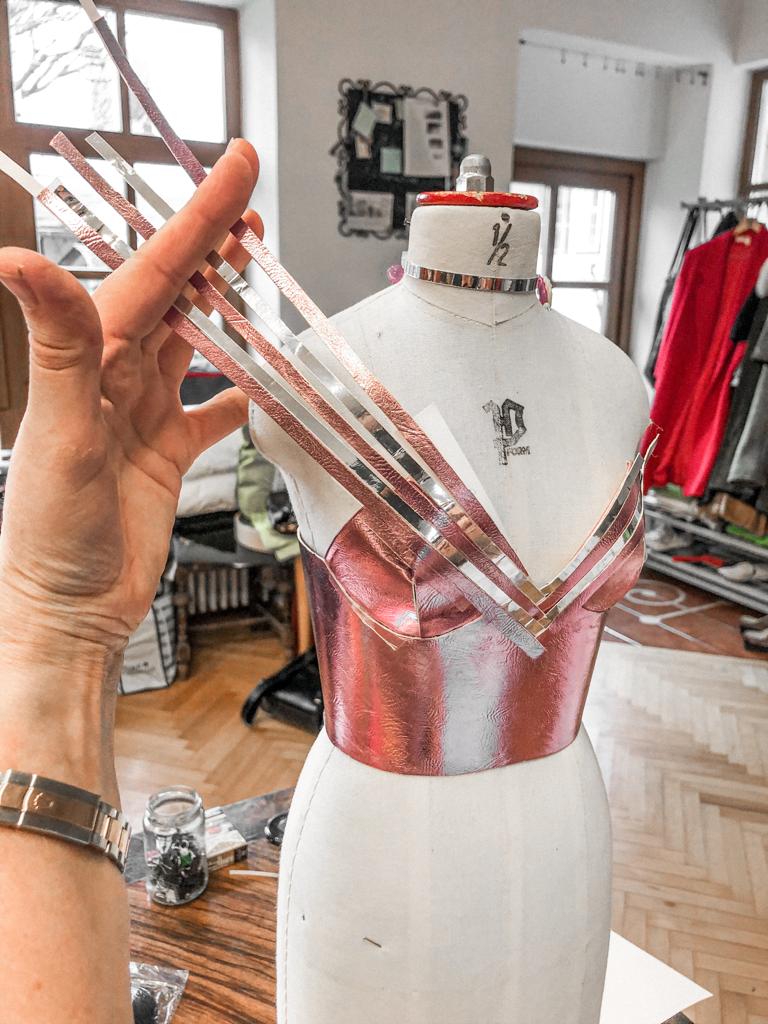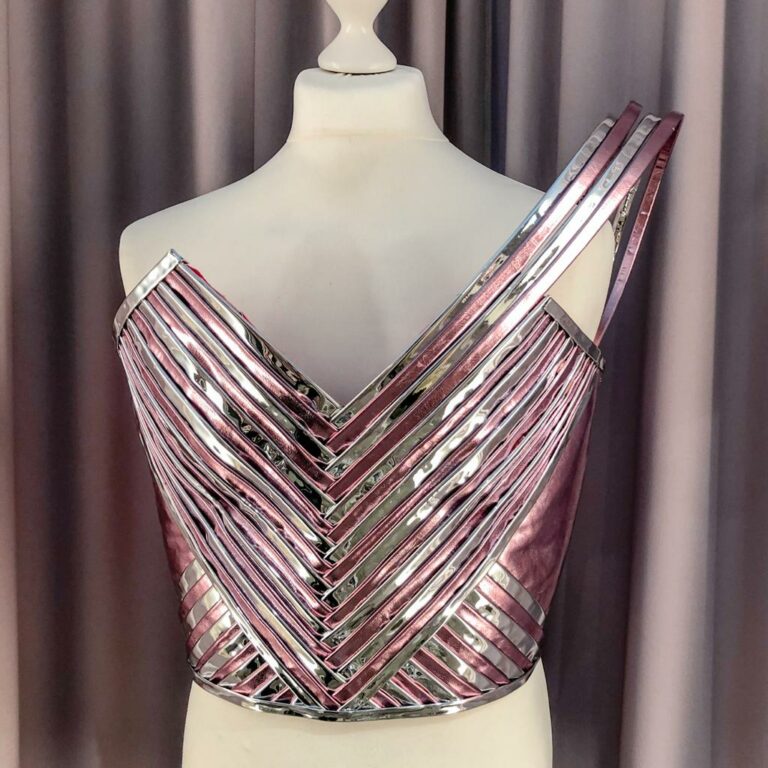Durch die Augen von Kostüm- und Bühnenbildner Diego Rojas
Marlene Pichelmayer
Costume-, Set- und Stage-Designer Diego Andrés Rojas Ortiz ist in Chile geboren und aufgewachsen. Seit mittlerweile 10 Jahren lebt er in Wien und hat nach seinem Studium an der Universität für Angewandte Kunst bereits an diversen nationalen und internationalen Projekten mitgewirkt. In seinen Arbeiten beschäftigt er sich mit verschiedenen Materialien und ihrer Interaktion mit dem menschlichen Körper. Inspiration findet er vor allem in der Natur und überträgt seine Beobachtungen auf seine Designs und Projekte.
(Titelbild von Heidi Pein)
Ich treffe mich mit Diego Rojas an einem Abend Anfang Dezember im Atelier einer Freundin im 1. Bezirk. Obwohl die Räumlichkeiten modern und hell eingerichtet sind, überwältigt mich die schiere Menge an Stoffen und Materialien, die hier untergebracht sind. Neben unzähligen Stoffbahnen aus Baumwolle, Leder, Satin, Seide und Spitze finden hier auch mehrere Nähmaschinen, Bügel-Stationen und Arbeitstische ihren Platz.
Rojas begrüßt mich herzlich, bietet mir einen Café oder ein Glas Sekt an und führt mich durch die Galerie. Er erklärt mir die unterschiedlichen Stoffe und ihre Verwendung für verschiedene Arten von Kostümen.
Hör dir an, wie verschiedene Stoffe klingen und wo sie Anwendung finden:

Wir setzen uns für das Interview auf die weiße Designer-Sitzgruppe im hinteren Teil des
Ateliers. Man merkt im Gespräch immer wieder, wie viel Leidenschaft und Passion für
Rojas hinter seinem Beruf stehen. Er redet mit Begeisterung über die vielen Details und
Besonderheiten seiner Arbeit und seiner Kunden.
Disclaimer: Das Interview wurde auf Englisch geführt. Um die Authentizität der Antworten
zu erhalten und Einheitlichkeit zu schaffen, wurde von einer Übersetzung abgesehen.
How did you become a costume- and stage designer?
Back in Chile I always wanted to be a special effect make-up artist. But there was no
schooling for this when I studied. So the closest thing I could do was a Bachelor in Arts
with a Master in Theatrical Design, which is Costume-, Stage- and Light-Design. After I
finished my studies in Chile I went to Europe to work on some projects. And I always had it in the back of my head that I didn’t want to go back to Chile and instead live, work and
study in in Europe. I came to Vienna and as a joke I applied to the University for Applied
Arts. But I got in and so thought, OK the decision is made.
Where do you find your inspiration?
Oh, everywhere! A lot in my dreams and in visual meditations. And also a lot in nature and
under water. In the textures of nature and especially in the movement of things.
What does one of your inspiring dreams look like?
Hör dir an, wie Rojas seine inspirierenden Träume beschreibt.
In the last years you mainly focused on costumes and designs for drag queens. How did you come to this?
Corona. (Lacht) In Corona time everything was closed. There was no theater, no cinema, no advertising – which are the fields I mainly work in. But I had a lot of creativity, so I talked with one of my friends, who said: „I want you to design 15 designs, everyday.“ So I would wake up every morning and do 15 random designs. And then I thought: Hey, this could be really good for drag queens. So I traveled to Holland with a suitcase full of materials that I was interested to work with and I just knocked on the doors of drag queens and said „Hi, I’m a costume designer! Do you need an outfit?“ (Lacht)
What is the process behind creating such costumes?
Hör dir an, wie der Prozess hinter der Gestaltung eines Kostüms aussieht.

What materials to you use for the costumes?
For the prototypes, I work a lot with paper and cardboards. For the costumes I work with real and fake leather, and with PVC and Neoprene fabrics. In general, for drag queens you also work with a lot of fantasy fabrics, like polyester satin. My favorite materials to work with are leather vinyl fabrics, which are very thick, so I can work with them in a very sculptural way.
Photograph by Cyriel Jacobs
Infokasten
Was sind PVC und Neopren-Stoffe?
PVC-Stoffe werden neben Zelten und Outdoor-Bekleidung auch als Kunstleder oder Lack verwendet. Neopren ist Synthetikkautschuk und wird vor allem für Tauch- und Surfanzüge verwendet. Der Stoff ist besonders elastisch und bietet eine große Bewegungsfreiheit.
How does the production of drag costumes differ from other costume designs or projects?
It differs a lot in the sense that, in every design you create a character. But if you work in film or theater, there is a script, there is a place the characters come from and go to, in a way. But when you create a drag queen, you create a character in itself. So the whole story is in the costume. Also, I mainly work with drag queens in Holland, but they are such a beautiful community. I also learned a lot from them, so many tricks, because, of course, everyone has a different way to do things. It’s a very supportive and beautiful community.
photo credits Diego Rojas
For you being part of the queer community yourself. Do you think that these unique pieces of clothing play a role in empowerment for this community also?
One-hundred percent. I do it with a lot of love because we share a lot of wounds as a community. And I think it’s very empowering. For me, it’s really beautiful to see how the way you move changes when you have the costume on, you feel very empowered and beautiful and ready to take over the world. And also rebel against a society that is trying to push you down, with an illusion of strength which also gives real strength to the people wearing them.
Hör dir an, wieso für Rojas Drag auch ein politisches Statement ist.
In which way do you think queer fashion has evolved in the last 10 years?
I think today we have a vocabulary to talk about things that we didn’t have 10 years ago. Which makes it easier to identify with different aspects of your body or the representation of fashion. And in general, I remember 13 years ago just wearing flowers as a man was not really allowed. Only if it was like a Hawaii-shirt maybe. (Lacht)
So you feel like it has evolved a lot?
Yes, it gives more freedom. A lot more freedom of expression.
And where do you think it will go from here?
Oh, to the digital world. (Lacht) To create things that are not possible to exist in the material world.
What part of your job are you most passionate for?
Diversity. I like to jump to different things, like doing drag costumes, film costumes, advertising. The fact that I can change between different areas and create a story and be part of a visual narrative, this is what I really like. And also the traveling. I love traveling and meeting people from different parts of the world, who work in the same field and learn from them.
What advice would you give to young people who want to become costume designers?
Hör dir an welchen Ratschlag Rojas angehenden Kostüm- und Bühnenbildner
mit auf den Weg gibt.








